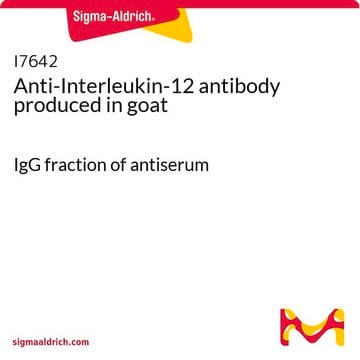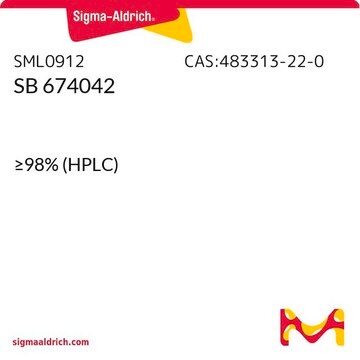I5395
Anti-Interleukin-12 antibody produced in goat
IgG fraction of antiserum, lyophilized powder
Synonym(s):
Anti-IL-12
Sign Into View Organizational & Contract Pricing
All Photos(1)
About This Item
Recommended Products
biological source
goat
Quality Level
conjugate
unconjugated
antibody form
IgG fraction of antiserum
antibody product type
primary antibodies
clone
polyclonal
form
lyophilized powder
species reactivity
human
technique(s)
neutralization: suitable
UniProt accession no.
storage temp.
−20°C
target post-translational modification
unmodified
Gene Information
human ... IL12A(3592)
General description
Interleukin-12 (IL-12) is an important cytokine that links innate and adaptive immunity. It plays a role in the regulation of Th1-associated cellular immunity to foreign pathogens, and humoral immunity to antigens that are both T cell-independent and T cell-dependent. IL-12 is primarily produced by innate immune cells, dendritic cells, epithelial cells and macrophages. All forms of IL-12 bind to the IL-12R which includes IL-12RbI and IL-12RbII subunits expressed on T cells and natural cells. IL-12 stimulates the production of IFN-γ and TNF-α, subsequent production of nitric oxide that leads to pathogen destruction. Reports suggest the involvement of JAK/STAT pathway components in mediating these effects. The effects of IL-12 have been implicated in bacterial, fungal and viral infections. Due to its role in inducing matrix metalloproteases, it also has important role in the etiology of chronic B-cell malignancies and lung adenocarcinomas
Anti-Interleukin-12 antibody recognizes human IL-12.
Anti-Interleukin-12 antibody recognizes human IL-12.
Specificity
The antibody neutralizes the biological activity of recombinant human IL-12.
Immunogen
recombinant human IL-12 expressed in Sf 21 insect cells.
Application
Anti-Interleukin-12 antibody may be used for ELISA at a working antibody concentration of 0.5 μg/ml. For immunoblotting, a working concentration of 1 μg/ml is recommended. The antibody is also suitable for neutralization reactions.
Physical form
Lyophilized from a 0.2 μm filtered solution in phosphate buffered saline
Preparation Note
Purified using protein G.
Disclaimer
Unless otherwise stated in our catalog or other company documentation accompanying the product(s), our products are intended for research use only and are not to be used for any other purpose, which includes but is not limited to, unauthorized commercial uses, in vitro diagnostic uses, ex vivo or in vivo therapeutic uses or any type of consumption or application to humans or animals.
Not finding the right product?
Try our Product Selector Tool.
Storage Class Code
11 - Combustible Solids
WGK
WGK 3
Flash Point(F)
Not applicable
Flash Point(C)
Not applicable
Personal Protective Equipment
dust mask type N95 (US), Eyeshields, Gloves
Certificates of Analysis (COA)
Search for Certificates of Analysis (COA) by entering the products Lot/Batch Number. Lot and Batch Numbers can be found on a product’s label following the words ‘Lot’ or ‘Batch’.
Already Own This Product?
Find documentation for the products that you have recently purchased in the Document Library.
Dennis W Metzger
Cytokine, 52(1-2), 102-107 (2010-07-24)
Interleukin (IL)-12 is a pivotal cytokine that strongly stimulates Th1-associated cellular immunity. It is now recognized that IL-12 also activates humoral immunity to both T-dependent and T-independent antigens. This has let to considerable interest in exploiting IL-12 as a vaccine
Anne O'Garra et al.
Nature immunology, 10(9), 929-932 (2009-08-21)
The authors recount their discovery of how pathogen-induced interleukin 12 production leads to T(H)1 T cell polarization. Simultaneously they discovered the suppressive cytokine interleukin 10 inhibits antigen-presenting cells, thus regulating development of T(H)1 cells.
IL-12 and Related Cytokines: Function and Regulatory Implications in Candida albicans Infection
Ashman RB et al
Clinical & Developmental Immunology, doi: 10-doi: 10 (2011)
David J Klinke
Molecular cancer, 9, 242-242 (2010-09-17)
Monoclonal antibodies represent some of the most promising molecular targeted immunotherapies. However, understanding mechanisms by which tumors evade elimination by the immune system of the host presents a significant challenge for developing effective cancer immunotherapies. The interaction of cancer cells
John L Langowski et al.
Nature, 442(7101), 461-465 (2006-05-12)
Chronic inflammation has long been associated with increased incidence of malignancy and similarities in the regulatory mechanisms have been suggested for more than a century. Infiltration of innate immune cells, elevated activities of matrix metalloproteases and increased angiogenesis and vasculature
Our team of scientists has experience in all areas of research including Life Science, Material Science, Chemical Synthesis, Chromatography, Analytical and many others.
Contact Technical Service







